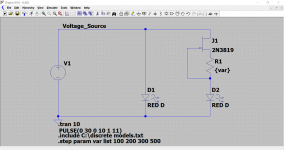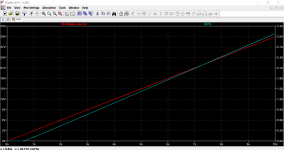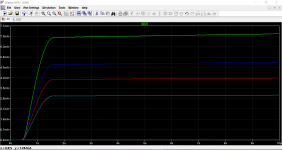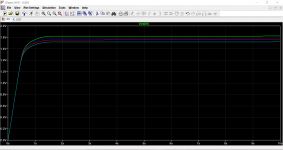Idss is the parameter to look for: it determines the maximum current when the set resistor=0.May I please ask what FET value in the datasheet do I have to look fore, to determine resulting current and Voltage output?
The resistor reduces that max to the desired value, and the shunt resistor across the LED allows the current to go to zero.
Voltage has no role in that, except it has to be sufficient to bias the LED and the FET properly.
A blue LED will need a higher voltage to function, as will a high Vp FET
All that is explained in my first comment, when I started this thread, did not thought it necessary to rewrite it until your comment. But I am glad that you asked, so no one do forget what it all started with.
But do you know the answer about my question in comment 35?
Must be me but I don’t see the slightest indication that it is meant for a luxmeter!?!
Not exactly in the first post, but it's there:Must be me but I don’t see the slightest indication that it is meant for a luxmeter!?!
Aren't we supposed to read all the relevant posts before posting ourselves anyway? (I readily admit that I am not the last person to quickly skim over a thread and give an inadequate answer....)Thanks, sorry but I do understand the word accuracy, but I may not understand your meaning with it, so please bear with me for this comment.
The LED is being used to calibrate my light-meter, non professional but do still need to be fairly consistence, I would like to be able to know that it just works!
Am just not able to do the necessary changes to the drawn circuit my self.
IMO the first post is the only working reference. Otherwise one must read ALL posts including answers based on misinterpretations. Besides that it is not logical it also creates confusion. It causes loss of time for goodwilling people that want to help out.
In this particular thread it is mentioned as you indicate in post #23 (!!!) so sorry but that is really confusing. See other posts, other members also misinterpreted.
Not being impolite but those that want information and/or answers should give all relevant details in the first post. I suggest this already more or less standard way of operation to be implemented in forum rules.
When helping out and sharing knowledge becomes a kind of computer game where the persons helping out should pass many levels to be able to formulate an adequate answer and the OP simply is offered the complete a la carte menu with all bells and whistles on any relevant or non relevant detail we are not on the right track.
In this particular thread it is mentioned as you indicate in post #23 (!!!) so sorry but that is really confusing. See other posts, other members also misinterpreted.
Not being impolite but those that want information and/or answers should give all relevant details in the first post. I suggest this already more or less standard way of operation to be implemented in forum rules.
When helping out and sharing knowledge becomes a kind of computer game where the persons helping out should pass many levels to be able to formulate an adequate answer and the OP simply is offered the complete a la carte menu with all bells and whistles on any relevant or non relevant detail we are not on the right track.
Last edited:
jean-paul you are completely correct and I am genuine glad you say it, I am new to all this and I do only learn if people like you do say what's wrong. So thank you very much!! 
EDIT: And thank you for being so polite about it!
Vovk-z thanks for the link, a bit hard to understand it all but what a joy to sink my teeth in
Elvee, thanks a lot, I just don't understand the part about Voltage being less important, I think that the circuit in post 35 do give 5V, but what if the LED is 3.3V or 12V?
Do the Voltage drop or how do the circuit react by i.e. adding several LED's in series / parallel?
EDIT: And thank you for being so polite about it!
Vovk-z thanks for the link, a bit hard to understand it all but what a joy to sink my teeth in
Elvee, thanks a lot, I just don't understand the part about Voltage being less important, I think that the circuit in post 35 do give 5V, but what if the LED is 3.3V or 12V?
Do the Voltage drop or how do the circuit react by i.e. adding several LED's in series / parallel?
Last edited:
A LED is not 3.3 or 12V. A LED is current driven and has a forward voltage that may be 1.6, 1.8 or even 4V (white and blue LEDs).
So current is the main parameter. When current is OK the voltage will be OK too. It will not be OK to throw a voltage on a LED without limiting/setting current. In the simplest form this leads to the standard current limiting resistor in series with a LED.
So current is the main parameter. When current is OK the voltage will be OK too. It will not be OK to throw a voltage on a LED without limiting/setting current. In the simplest form this leads to the standard current limiting resistor in series with a LED.
Last edited:
Okay sounds very interesting and outside what I am used to, but no problem getting used to current and voltage in that way, when it's about current sources
Yes sorry by keep using the Voltage specification, but I do just try to explain my question in noob-ish
But do that mean a "4V" LED will light up by using a current source from a 1.2V, as long the current is correct? That 100V or 1V do mean exactly the same for the LED as long the current is correct?
Yes sorry by keep using the Voltage specification, but I do just try to explain my question in noob-ish
But do that mean a "4V" LED will light up by using a current source from a 1.2V, as long the current is correct? That 100V or 1V do mean exactly the same for the LED as long the current is correct?
Does this help?
The circuit shows an LED connected across a voltage source and also an LED connected to a FET.
Look at the scales, the voltage is at the left and the current is at the right for the first LED. The LED draws no current until there is sufficient voltage to turn it on. Once that point is reached the current rises dramatically for even a very small change of voltage.
A real LED would be destroyed doing this.
The colour of the LED determines the voltage needed before it begins to conduct... that's just the way it is and is that way because of the different chemical structures needed for the different colours. They all have different forward voltage drops.
The FET current regulator shows the LED current vs the supply voltage. Current is at the left scale now.
There are four different values of resistor used in the sim, each one gives a different current (the actual values are those in the 'variable' list on the sim).
Look how constant the current is as the supply voltage alters. The supply is still going from 0 to 30 volts. Once there is enough voltage for the LED to turn on plus a little bit for the FET to work the circuit regulates the current.
The LED voltage doesn't really change for any of the different currents... a bit like a Zener diode.
Last image shows the LED voltage for those different currents. It is about 1.8 volts which is the forward voltage of a red LED.
The circuit shows an LED connected across a voltage source and also an LED connected to a FET.
Look at the scales, the voltage is at the left and the current is at the right for the first LED. The LED draws no current until there is sufficient voltage to turn it on. Once that point is reached the current rises dramatically for even a very small change of voltage.
A real LED would be destroyed doing this.
The colour of the LED determines the voltage needed before it begins to conduct... that's just the way it is and is that way because of the different chemical structures needed for the different colours. They all have different forward voltage drops.
The FET current regulator shows the LED current vs the supply voltage. Current is at the left scale now.
There are four different values of resistor used in the sim, each one gives a different current (the actual values are those in the 'variable' list on the sim).
Look how constant the current is as the supply voltage alters. The supply is still going from 0 to 30 volts. Once there is enough voltage for the LED to turn on plus a little bit for the FET to work the circuit regulates the current.
The LED voltage doesn't really change for any of the different currents... a bit like a Zener diode.
Last image shows the LED voltage for those different currents. It is about 1.8 volts which is the forward voltage of a red LED.
Attachments
Thanks! Yes you are completely correct and I do read a lot, but until I stumble upon something, do I not know I need to know it. 
Literature in Denmark is about non existing, some of the literature I have found is a children book from 1980 about making a light bulb glow by connecting it to a 1.5V battery on a wooden board with nails.
There are nowhere, you can be educated unless you do go to the university in electronic engineering.
There are nu clubs, interest groups or things like that.
If you search on the internet do you have to know what to search fore, so I do all sort of small projects and search for that. When I meed something that are to strange, I ask you in here and I learn hundreds of new subjects, I do have to read up on.
And English is not my strong side, so I do also have to learn new words while learning electronic.
But no matter all that, it's fun and interesting!!
Literature in Denmark is about non existing, some of the literature I have found is a children book from 1980 about making a light bulb glow by connecting it to a 1.5V battery on a wooden board with nails.
There are nowhere, you can be educated unless you do go to the university in electronic engineering.
There are nu clubs, interest groups or things like that.
If you search on the internet do you have to know what to search fore, so I do all sort of small projects and search for that. When I meed something that are to strange, I ask you in here and I learn hundreds of new subjects, I do have to read up on.
And English is not my strong side, so I do also have to learn new words while learning electronic.
But no matter all that, it's fun and interesting!!
9...I would like to advise reading yourself into this knowledge.
The Art Of Electronics
It is also good English, mostly.
- Status
- This old topic is closed. If you want to reopen this topic, contact a moderator using the "Report Post" button.
- Home
- Design & Build
- Construction Tips
- Single diode dimmer - how?



